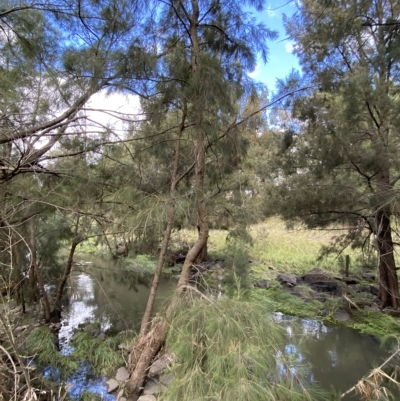Casuarina cunninghamiana subsp. cunninghamiana (River She-Oak, River Oak)
River She-oak as a food source for Yellow-tailed Black Cockatoo(YTBC).
The ACT's Casuarina cunninghamiana appear to be important in the diets of YTBC; possibly more so than the exotic pines with which they are commonly associated. Pines are plentiful (more than 12, 500 in the urban Ginninderra Ck catchment alone) and are good sources of energy. But, as with fast foods generally, they are low in protein; important during the peak of YTBC annual visits when there are many growing juvenilles in the flocks. Native seeds have higher protein contents, and visiting YTBCs eat some hakea, acacia, casuarina and other native seeds. More importantly, acacias and casuarinas are commonly infested by wood-boring moth larvae. In urban ACT, while Cossid Moth larvae appear to be available in acacias episodically, casuarinas seem to harbour plentiful larvae of Cryptophasa irrorata throughout the year. Casuarinas may be the most reliable source of protein for YTBC in the ACT.
For more information see the following study by Daryl King
Casuarina cunninghamiana subsp. cunninghamiana is listed in the following regions:
Canberra & Southern Tablelands | Albury, Wodonga | South Coast | Central West NSW | New England | Townsville
Species information
- Casuarina cunninghamiana subsp. cunninghamiana Scientific name
- River She-Oak, River Oak Common name
- Not Sensitive
- Local native
- Non-invasive or negligible
- Up to 968.28m Recorded at altitude
- Machine learning
-
In flower
Location information
-
Maps
Bruce Ridge Bruce Ridge to Gossan Hill Bullen Range Bungonia National Park Bungonia State Conservation Area Canberra City Farm Commonwealth & Kings Parks Cotter Reserve Flea Bog Flat, Bruce Giralang Wetlands Googong Foreshore Goulburn Mulwaree Council Higgins Woodland Holder Wetlands Isabella Pond Jarramlee Pond Jarramlee-West MacGregor Grasslands Jerrabomberra Wetlands Kambah Pool Kuringa Woodlands Lake Burley Griffin West Lake Ginninderra Lake Tuggeranong Lions Youth Haven - Westwood Farm A.C.T. Molonglo River Reserve Mount Ainslie to Black Mountain Pine Island to Point Hut Point Hut Pond Point Hut to Tharwa Tuggeranong Creek to Monash Grassland Umbagong District Park Upper Stranger Pond Urambi Hills Uriarra Recreation Reserve Watson Green Space West Belconnen Pond Woodstock Nature Reserve Yerrabi Pond -
Places
Amaroo, ACT Bungonia, NSW Evatt, ACT Fyshwick, ACT Holder, ACT Kambah, ACT Mitchell, ACT Wallaroo, NSW Wee Jasper, NSW Whitlam, ACT Yarrow, NSW



























































































































































































